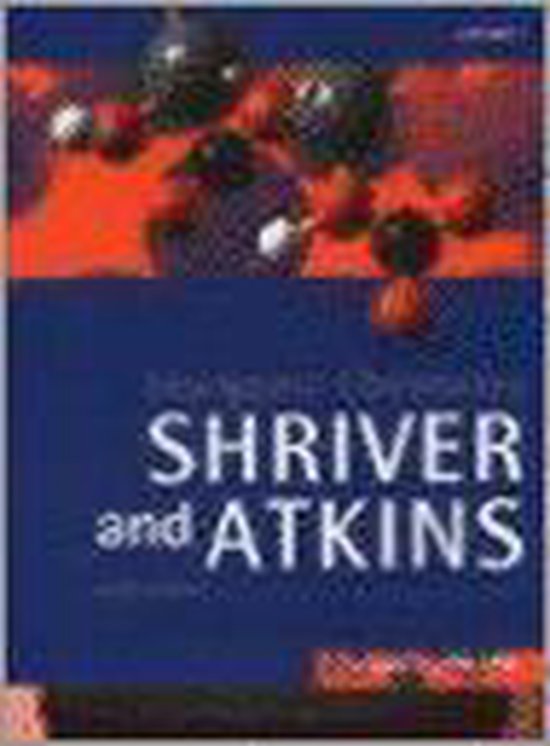
Shriver And Atkins' Inorganic Chemistry
Shriver and Atkins' Inorganic Chemistry fifth edition represents an integral part of a student's chemistry education. With the same broad coverage as its predecessors - making it the ideal companion for the duration of an undergraduate degree programme - the fifth edition extends from the foundational concepts of inorganic chemistry to the forefront of contemporary research.
The book seeks not just to impart knowledge, but to engage and enthuse its readers. Its unique 'Frontiers' chapters cover materials science, nanotechnology, catalysis, and biological inorganic chemistry, and have been fully updated to reflect advances in these key areas of contemporary research and industrial application. Further, examples throughout show the relevance of inorganic chemistry to real-life situations, to encourage students to engage fully with the subject.
Inorganic chemistry spans a huge range of elements, whose characteristic similarities and differences students must be familiar with. Inorganic Chemistry rises to this challenge by setting out the key trends exhibited within the periodic table, and by the elements comprising each Group. These trends and behaviours are illuminated with illustrative examples, placing the content in a clear, relevant context.
New to this edition:
- The introduction of a new chapter on periodic trends provides an accessible outline for students of the major trends exhibited by the chemical elements, before the descriptive chemistry is covered in detail throughout the rest of Part 2
- Additional worked examples actively engage students and test their understanding
- Major revision of chapter 10, 'Hydrogen', to introduce technologically relevant nuclear properties, renewable hydrogen production, and complexes of transition metals with hydrido or dihydrogen ligands
- Increased coverage of 'green chemistry'
- A new approach to presenting the descriptive chemistry chapters in Part 2 splits the content into 'Essentials' and 'Details', providing students with a summary of the key reactions of each group before drilling down into more detail, resulting in a greater focus on periodicity and the highlighting of key trends
- Expanded use of contextual examples shows the relevance of inorganic chemistry to real-life situations, and encourages students to engage fully with the subject
- Extensive cross-referencing between the descriptive chemistry chapters and the new periodic trends chapter enables students to place each group of elements in context
- Key terms are highlighted within each chapter and explained fully at their initial occurrence, aiding comprehension of difficult concepts and allowing students to recognise them more readily
- The inclusion of a new 'brief illustration' feature provides the reader with an introduction and cross reference to key pieces of descriptive chemistry in Parts 2 and 3, and guides students' reading directly to the further information available
- Notes on good practice highlight common pitfalls for students to look out for and offer guidance on issues including terminology, use of units, and nomenclature
- The full colour text design and artwork has been modernised and refreshed, to continue to stimulate and engage students
The book seeks not just to impart knowledge, but to engage and enthuse its readers. Its unique 'Frontiers' chapters cover materials science, nanotechnology, catalysis, and biological inorganic chemistry, and have been fully updated to reflect advances in these key areas of contemporary research and industrial application. Further, examples throughout show the relevance of inorganic chemistry to real-life situations, to encourage students to engage fully with the subject.
Inorganic chemistry spans a huge range of elements, whose characteristic similarities and differences students must be familiar with. Inorganic Chemistry rises to this challenge by setting out the key trends exhibited within the periodic table, and by the elements comprising each Group. These trends and behaviours are illuminated with illustrative examples, placing the content in a clear, relevant context.
New to this edition:
- The introduction of a new chapter on periodic trends provides an accessible outline for students of the major trends exhibited by the chemical elements, before the descriptive chemistry is covered in detail throughout the rest of Part 2
- Additional worked examples actively engage students and test their understanding
- Major revision of chapter 10, 'Hydrogen', to introduce technologically relevant nuclear properties, renewable hydrogen production, and complexes of transition metals with hydrido or dihydrogen ligands
- Increased coverage of 'green chemistry'
- A new approach to presenting the descriptive chemistry chapters in Part 2 splits the content into 'Essentials' and 'Details', providing students with a summary of the key reactions of each group before drilling down into more detail, resulting in a greater focus on periodicity and the highlighting of key trends
- Expanded use of contextual examples shows the relevance of inorganic chemistry to real-life situations, and encourages students to engage fully with the subject
- Extensive cross-referencing between the descriptive chemistry chapters and the new periodic trends chapter enables students to place each group of elements in context
- Key terms are highlighted within each chapter and explained fully at their initial occurrence, aiding comprehension of difficult concepts and allowing students to recognise them more readily
- The inclusion of a new 'brief illustration' feature provides the reader with an introduction and cross reference to key pieces of descriptive chemistry in Parts 2 and 3, and guides students' reading directly to the further information available
- Notes on good practice highlight common pitfalls for students to look out for and offer guidance on issues including terminology, use of units, and nomenclature
- The full colour text design and artwork has been modernised and refreshed, to continue to stimulate and engage students
| Auteur | | Peter Atkins |
| Taal | | Engels |
| Type | | Paperback |
| Categorie | | Wetenschap & Natuur |





